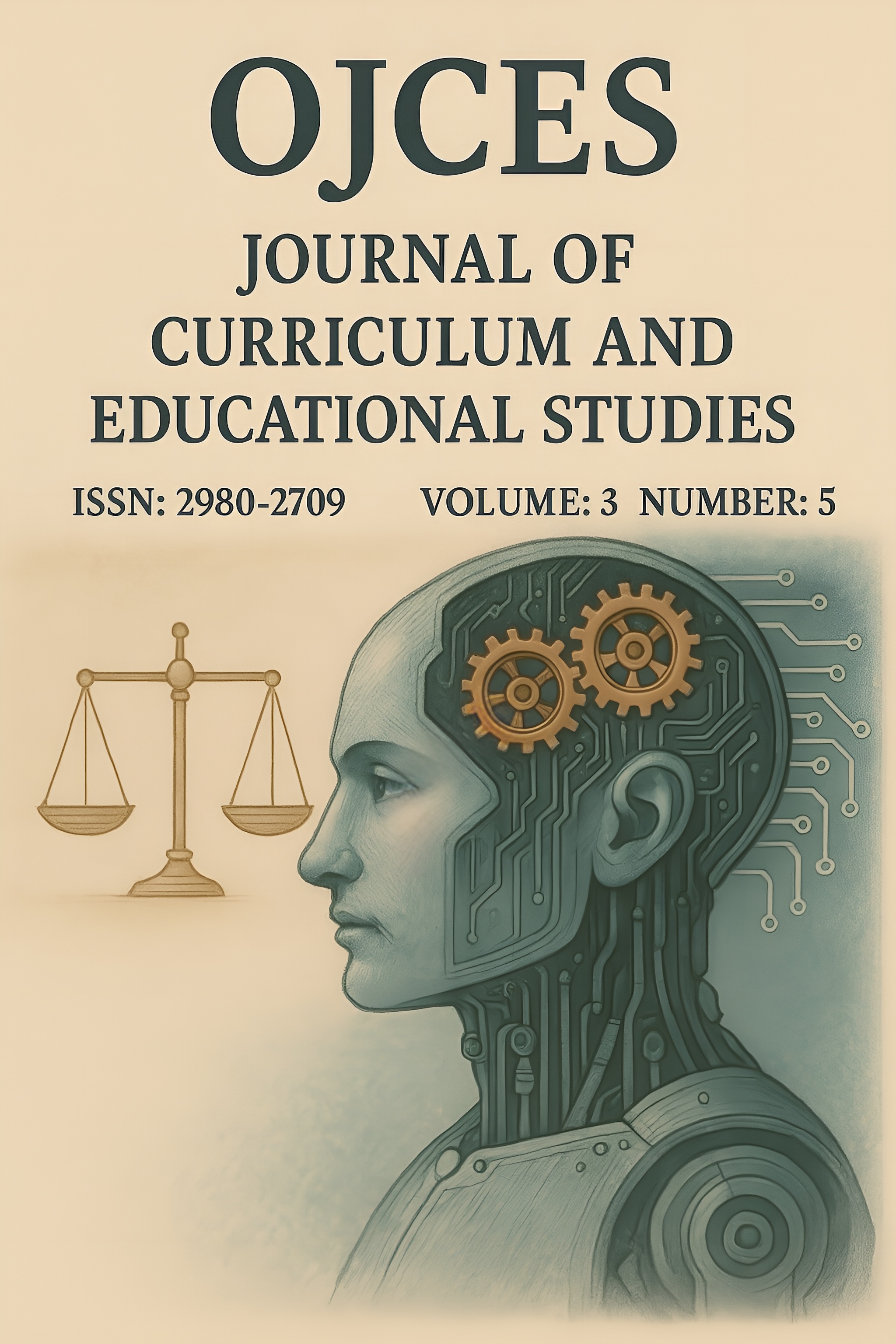Development and Validation of the Brain Rot Scale
DOI:
https://doi.org/10.5281/zenodo.15676357Keywords:
Brain rot, psikometrik özellikler, sosyal medya bağımlılığıAbstract
In this study, the psychometric properties of the Brain Fatigue Scale, which aims to measure cognitive and psychological burnout experienced by individuals in the digital age, were examined. The scale consists of a total of 8 items and two dimensions (Cognitive fatigue and mental exhaustion). According to confirmatory factor analysis, the factor loadings of the items ranged between .527 and .804, the variance explained (AVE) value was .53, and the composite reliability (CR) value was .90. These findings show that the construct validity of the scale is sufficient. The internal consistency of the scale was evaluated with Cronbach's Alpha (α=.83) and McDonald's Omega (ω=.83) coefficients, and both coefficients being above .70 indicate that the reliability of the scale is high. In addition, significant positive correlations were found between the Brain Fatigue Scale and social media addiction (r=.50, p<.05) and FOMO (r=.28, p<.05). These results suggest that the scale may be functional in predicting the psychological difficulties of the digital age.
References
Alotaibi, M. S., Fox, M., Coman, R., Ratan, Z. A., & Hosseinzadeh, H. (2022). Smartphone addiction prevalence and its association on academic performance, physical health, and mental well-being among university students in Umm Al-Qura University (UQU), Saudi Arabia. International Journal of Environmental Research and Public Health, 19(6), 3710. https://doi.org/10.3390/ijerph19063710
Andreassen, C. S., Pallesen, S., & Griffiths, M. D. (2017). The relationship between addictive use of social media, narcissism, and self-esteem: Findings from a large national survey. Addictive Behaviors, 64, 287-293. http://dx.doi.org/10.1016/j.addbeh.2016.03.006
Cheng, L., Fang, G., Zhang, X., Lv, Y., & Liu, L. (2024). Impact of social media use on critical thinking ability of university students. Library Hi Tech, 42(2), 642-669. https://doi.org/10.1108/LHT-11-2021-0393
Çokluk, Ö., Şekercioğlu, G., & Büyüköztürk, Ş. (2012). Sosyal bilimler için çok değişkenli istatistik: SPSS ve LISREL uygulamaları (Vol. 2). Ankara: Pegem akademi.
Çutuk, Z. A. (2021). Investigating the relationship among social media addiction, cognitive absorption, and self-esteem. Malaysian Online Journal of Educational Technology, 9(2), 42-51. https://doi.org/10.52380/mojet.2021.9.2.211
Demirci, İ. (2019) Bergen sosyal medya bağımlılığı ölçeğinin Türkçeye uyarlanması, depresyon ve anksiyete belirtileriyle ilişkisinin değerlendirilmesi. Anadolu Psikiyatri Dergisi, 20(Ek sayı 1), 15-22. http://dx.doi.org/10.5455/apd.41585
Dündar, S., Ekşi, H., Yıldız, A., & Yıldız, A. (2008). Aksiyonda Değerler Ölçeği Dilsel Eşdeğerlik Geçerlik ve Güvenirlik Çalışması. Değerler Eğitimi Dergisi, 6(15), 89-110.
Flynn, B., Schroeder, R., & Sakakibara, S. (1994). A framework for quality management research and an associated measurement instrument. Journal of Operations Management, 11, 339-366. http://dx.doi.org/10.1016/S0272-6963(97)90004-8
Gökler, M. E., Aydin, R., Unal, E., & Metintas, S. (2016). Determining validity and reliability of Turkish version of Fear of Missing out Scale/Sosyal Ortamlarda Gelismeleri Kacirma Korkusu Olceginin Turkce surumunun gecerlilik ve guvenilirliginin degerlendirilmesi. Anadolu Psikiyatri Dergisi, 17(S1), 53-60. https://doi.org/10.5455/apd.195843
Heidegger, M. (1993). Letter on humanism. Basic writings. Trans. Frank A. Capuzzi and J. Glenn Gray. Ed. David Farrell Krell. HarperCollins.
Kalın, İ. (2024). Açık ufuk. İnsan Yayıncılık.
Koessmeier, C., & Büttner, O. B. (2024). Social media distraction: How distracting are visual social media cues and what influences users' distractibility?. Computers in Human Behavior, 159, 108306. https://doi.org/10.1016/j.chb.2024.108306
Kwok, C., Leung, P. Y., Poon, K. Y., & Fung, X. C. (2021). The effects of internet gaming and social media use on physical activity, sleep, quality of life, and academic performance among university students in Hong Kong: A preliminary study. Asian Journal of Social Health and Behavior, 4(1), 36-44. https://doi.org/10.4103/shb.shb_81_20
Le Bon, G. (2011). Kitleler psikolojisi (Çev. İlhan, H.) Alter Yayıncılık.
Mosharrafa, R. A., Akther, T., & Siddique, F. K. (2024). Impact of social media usage on academic performance of university students: Mediating role of mental health under a cross‐sectional study in Bangladesh. Health Science Reports, 7(1), e1788. https://doi.org/10.1002/hsr2.1788
Oxford University Press (2025). Brain Rot. https://corp.oup.com/news/brain-rot-named-oxford-word-of-the-year-2024/
Przybylski, A. K., Murayama, K., DeHaan, C. R., & Gladwell, V. (2013). Motivational, emotional, and behavioral correlates of fear of missing out. Computers in Human Behavior, 29(4), 1841-1848. https://doi.org/10.1016/j.chb.2013.02.014
Sagar, M. E. (2021). Predictive Role of Cognitive Flexibility and Self-Control on Social Media Addiction in University Students. International Education Studies, 14(4), 1-10. https://doi.org/10.5539/ies.v14n4p1
Schermelleh-Engel, K., Moosbrugger, H., & Müller, H. (2003). Evaluating the fit of structural equation models: Tests of significance and descriptive goodness-of-fit measures. Methods of Psychological Research Online, 8, 23-74.
Siebers, T., Beyens, I., Pouwels, J. L., & Valkenburg, P. M. (2023). Explaining variation in adolescents’ social media-related distraction: The role of social connectivity and disconnectivity factors. Current Psychology, 42(34), 29955-29968. https://doi.org/10.1007/s12144-022-03844-y
Spahi, B. Yurtkoru, E. S., & Çinko, M. (2008). Sosyal bilimlerde SPSS’le veri analizi. İstanbul: Beta Basım Yayım Dağıtım.
Sujarwoto, Saputri, R. A. M., & Yumarni, T. (2023). Social media addiction and mental health among university students during the COVID-19 pandemic in Indonesia. International Journal of Mental Health and Addiction, 21(1), 96-110. https://doi.org/10.1007/s11469-021-00582-3
Sümen, A., & Evgin, D. (2021). Social media addiction in high school students: a cross-sectional study examining its relationship with sleep quality and psychological problems. Child Indicators Research, 14(6), 2265-2283. https://doi.org/10.1007/s12187-021-09838-9
Tanhan, F., Özok, H. İ., Kaya, A., & Yıldırım, M. (2024). Mediating and moderating effects of cognitive flexibility in the relationship between social media addiction and phubbing. Current Psychology, 43(1), 192-203. https://doi.org/10.1007/s12144-023-04242-8
Xie, J. Q., Rost, D. H., Wang, F. X., Wang, J. L., & Monk, R. L. (2021). The association between excessive social media use and distraction: An eye movement tracking study. Information & Management, 58(2), 103415. https://doi.org/10.1016/j.im.2020.103415
Yue, Z., Lee, D. S., Xiao, J., & Zhang, R. (2023). Social media use, psychological well-being and physical health during lockdown. Information, Communication & Society, 26(7), 1452-1469. https://doi.org/10.1080/1369118X.2021.2013917
Downloads
Published
How to Cite
Issue
Section
License
Copyright (c) 2025 Journal of Curriculum and Educational Studies

This work is licensed under a Creative Commons Attribution 4.0 International License.



